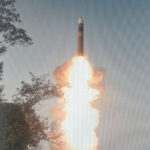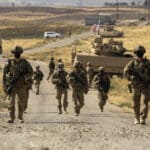Facing the central questions of nuclear disarmament
By Aaron Miles | September 10, 2018

In the leadup to his summit with Russian President Vladimir Putin, headline writers jumped on President Trump’s statement that the “ultimate deal” would be a world without nuclear weapons. Trump’s full statement was even more ambitious and more encompassing; what he actually said was: “What would be the ultimate? Let’s see. No more nuclear weapons anywhere in the world, no more wars, no more problems, no more conflicts.”
At first glance, it may all sound like nothing more than a pipe dream.
But Trump actually landed on something that contains a good bit of truth: The goal of eliminating nuclear weapons cannot safely be separated from the ultimate goal of eliminating the reasons why nuclear weapons were ever developed in the first place. And the tendency to extract a headline fragment from the rest of the statement reflects a longstanding problem with how many people treat the question of nuclear disarmament.
Why now? Following repeated rounds of deep cuts in US and Russian nuclear arsenals, the two countries are approaching a tipping point where they will begin to question their ability to prevent nuclear war through the threat of mutually assured destruction. Further progress towards nuclear disarmament will require that all concerned grapple with two central questions: In a world where states have eliminated nuclear weapons but retained the knowledge and the technology to produce them, how do we ensure that no state will rearm with nuclear weapons during a future war? If we cannot rule out nuclear rearmament in war, how do we instead progress toward a world where war itself cannot happen?
Neither question is new, but both are often ignored. These end-state considerations should guide the intermediate steps nations choose to pursue, and are consistent with the “conditions-based” approach the US State Department recently emphasized. As Christopher Ashley Ford, Assistant Secretary of State for International Security and Non-Proliferation, put it: “… it is futile to think one can reduce the number of nuclear weapons in the world if one ignores the challenges presented by such [geopolitical] conditions (read North Korea and Iran)—and, in particular, if one ignores the obstacles to further disarmament progress presented by the worsening conditions that confront us all today.”
This year marks a good time to reflect on the challenge of nuclear disarmament. Fifty years ago, the Treaty on the Non-Proliferation of Nuclear Weapons (more commonly known as the Nuclear Nonproliferation Treaty, or NPT) opened for its first round of signatures. Under the NPT, the nuclear weapon states pledge not to assist others in acquiring nuclear weapons, and non-nuclear weapon states pledge to remain non-nuclear. All signatories—nuclear and non-nuclear alike—commit to work towards global disarmament. There are differing views on the NPT’s historical success in stemming nuclear proliferation, and even more debate over whether states are living up to their obligations related to nuclear disarmament. The outcome of this debate may determine the treaty’s durability over and beyond the next 50 years.
Since the advent of the NPT, the United States and Russia ceased their nuclear buildups and decreased the size of their arsenals by about 85 percent. Both sides were careful to implement these cuts in ways that preserved their ability to deter nuclear war. This included ensuring they could still strike back with devastating effect if the other attacked first. But as US and Russian stockpiles move lower, preserving stable and effective deterrence will become increasingly difficult.
Further nuclear arms reductions are possible, but they are only good if they make the world safer. Eventually, fundamental changes to the deterrence equation will replace strategic stability with competitions for tactical surprise. Smaller stockpiles place a higher premium on capabilities for locating and targeting hidden weapons. Consequently, preemptive strikes that offer no advantage under present circumstances may instead become tempting in the depths of a severe crisis in the future. Similarly, while there is no effective defense against large-scale ballistic missile attacks today, defense will look increasingly viable as missile forces decrease in size and the meaning of “large-scale attack” diminishes proportionally. Missile defense would then increase pressure to escalate a crisis to nuclear war, because striking some portion of the enemy’s weapons on the ground would decrease the number to intercept in the air.
New technologies and evolving domains of competition will further complicate the challenge of maintaining stable deterrence at low numbers. For example, advanced space-based sensors and weapons may offer new ways of threatening an adversary’s deterrent. Maneuvering hypersonic weapons might help evade missile defenses, but some worry they might also enable more effective preemptive strikes. There are other potentially destabilizing technologies on the near-horizon as well, such as autonomous battlefield weapons using robots equipped with artificial intelligence. Some of these technologies may still sound like science fiction, but R&D is actively underway and is already delivering very real-world results; it is astounding how different our world is now from the one of a couple of decades ago, before the spread of the internet, social media, botnets, cyberattacks, GPS satellites, RFID chips, self-driving vehicles, and smartphones. And as artificial intelligence continues to grow in sophistication and ubiquity, it may affect the offense-defense balance in a number of meaningful ways..
The danger of weakening deterrence and stability contributed to slowing the pace of US and Russian nuclear reductions over the last decade. Even at the current levels of 1,550 accountable warheads under the New START Treaty, Russians expressed fears of what they perceive as the looming ability of US advanced conventional weapons to target Russia’s strategic deterrent. The Obama Administration determined that both sides could safely reduce their deployed strategic weapons by an additional one-third, but even that new elimination of a few hundred weapons per side would be a far cry from the deep cuts of the past.
It is time for NPT signatories to face some hard questions regarding nuclear disarmament. First, how can nations establish mutual confidence in their readiness to fight and lose major wars without deciding to redevelop nuclear weapons? In a major war involving two or more nations with this capacity, there would be tremendous incentives to rearm first and use the weapon to stop the other side from doing the same. These incentives would be much greater than they were during World War II. Few then understood the potential for nuclear weapons or had the technical knowhow to build them, and yet in the midst of that all-consuming war Germany still sought the bomb and the United States acquired and used it. Without the instruments of mutual deterrence, and with fear of what the other side might do if it gets there first, nuclear use in that scenario would be far more likely than it is today.
Absent a compelling answer to the question of nuclear rearmament in war, nations must accept the paradoxical but very real possibility that nuclear disarmament might do more than any other single act to increase the risk of nuclear war. In that case, the only safe way to banish nuclear weapons is to first banish war. This leads to the second central question of nuclear disarmament: How can nations establish a world where none view armed conflict as a viable means to resolving disputes? Given the existential risk of re-nuclearization in war, this requires confidence much greater than can be obtained through merely a period of reduced tensions and violence, or an agreement like the Kellogg-Briand Pact that famously outlawed war in 1928. As Nobel prize winning economist and deterrence theorist Thomas Schelling noted, “One might hope that major war could not happen in a world without nuclear weapons, but it always did.”
The drafters of the NPT recognized that nuclear disarmament is inseparable from that grand challenge of international relations. As in Trump’s recent statement, they built this understanding into the text using words that are too often treated as casual throwaway lines by those who continue to advocate for fast and deep nuclear cuts. While calling for an early “cessation of the nuclear arms race,” the NPT preamble admits the objective of nuclear disarmament only “pursuant to a Treaty on general and complete disarmament under strict and effective international control, [r]ecalling that… States must refrain in their international relations from the threat or use of force…” Similarly, under the treaty’s disarmament clause, signatories commit that each “undertakes to pursue negotiations in good faith on effective measures relating to cessation of the nuclear arms race at an early date and to nuclear disarmament, and on a treaty on general and complete disarmament under strict and effective international control” (emphasis added). This carefully—almost tortuously—qualified disarmament language stands in stark contrast to the precise commitments laid out in the NPT’s clauses on nuclear proliferation. The drafters understood that the only hope for concluding the NPT is in answering the second central question and cooperatively eliminating the potential of nations to wage war, including their armies, navies, and nuclear weapons.
Long-term versus short-term. The short-sighted path towards nuclear disarmament is to continue deep nuclear cuts now and worry later about sorting the broader security challenges. In addition to possibly increasing rather than decreasing the risk of major war—including nuclear war—this approach rejects the responsibility of constructing an end state that offers safety and security.
The honest path towards nuclear disarmament is for NPT signatories to work together to answer one or both of the central questions. The honesty of this path lies in its acknowledgement that if general disarmament is too lofty an endeavor, then so is nuclear disarmament. If nations choose to focus on the first rather than the second central question, then pursuing “negotiations…on effective measures relating to…nuclear disarmament” should mean developing the technical, diplomatic, and military means to rule out nuclear rearmament in the midst of major war.
Starting from where we are today, real progress under the NPT disarmament clause is about creating the conditions for general and complete disarmament. Continuing rounds of deep nuclear cuts are not the next big step. Instead, the next major step in implementing states’ disarmament obligations is achieving full and lasting resolution of major international disputes, includes those in the Middle East, Ukraine, the Korean Peninsula, the South China Sea, and South Asia. This work is not ancillary to states’ NPT commitments, but rather a primary means for all signatories to fulfill their obligations. Under the NPT, the burden of working towards general disarmament falls as heavily on the non-nuclear weapon states as it does on the nuclear weapon states. For the former, the task is of course much harder than seeking to apply pressure on the nuclear weapon states to reduce their arsenals, or signing on to a nuclear weapons ban treaty that principally reaffirms commitments already made under the NPT.
The NPT commits signatories to work towards an end state—general disarmament, including nuclear disarmament—that the world will probably never reach. The only prudent path towards an unobtainable objective is one along which incremental progress provides tangible benefits while avoiding greater dangers. Artificially splitting nuclear disarmament off from general disarmament and pretending it has a shorter time horizon invites intermediate steps that would weaken stability and deterrence without moving the world closer to absolute security. Though the honest path the NPT drafters envisioned may appear less hopeful and more daunting than its myopic alternative, it benefits from intermediate steps (resolving major conflicts) that offer tangible relief rather than greater danger of nuclear war.
Perhaps the latest efforts at re-resetting US-Russian relations will lead eventually to a new bilateral agreement on further nuclear reductions, or at least a five-year extension of the New START Treaty. Either of those outcomes might be a good thing, but nuclear disarmament is not the ultimate objective of the NPT. The stated objective of the NPT is “to avert the danger of [a nuclear] war.” Its provisions follow from the expressed assumption “that the proliferation of nuclear weapons would seriously enhance the danger of nuclear war,” but not an assumption that nuclear disarmament—absent complete and general disarmament—would reduce that danger. Resolving conflicts and removing their drivers is the only real way to diminish the need to maintain the means of deterrence. Over the next 50 years, engaging in that work is the way to fulfil NPT disarmament obligations.
Together, we make the world safer.
The Bulletin elevates expert voices above the noise. But as an independent nonprofit organization, our operations depend on the support of readers like you. Help us continue to deliver quality journalism that holds leaders accountable. Your support of our work at any level is important. In return, we promise our coverage will be understandable, influential, vigilant, solution-oriented, and fair-minded. Together we can make a difference.
Keywords: NPT, disarmament, missile proliferation
Topics: Analysis, Disruptive Technologies, Nuclear Risk
















Hi — your article is very thoughtful and insightful, but I am nagged by a couple of questions you don’t address: 1. If not zero, what is the ideal number of nuclear weapons in the world that minimizes risk of global nuclear catastrophe? The US and Russian have enough nuclear firepower to destroy civilization several times over. It’s highly unlikely that missile defense or a pre-emptive strike can destroy either side’s capability (or even come close). So it seems to me further deep cuts are still possible without undermining deterrence significantly. And cutting nuclear weapons arsenals will reduce the risk… Read more »
This is an excellent article. I will read it more depth but would like to make a view comments. The whole question of re-armament in future war, where nuclear weapons had been abolished, is a challenging one. The question is: why do nations go to war? There are two things that need to be protected: core interest and survival. The two are interlinked, the former influenced the latter. All the evidence points towards nuclear war. The pattern of history is clear. Power (manifested as interest) has been present in every conflict throughout history – no exception. It is the underlying… Read more »
There is a possible solution now underway to the dilemma of nuclear disarmament that this author so clearly describes. He correctly notes that we won’t eliminate the danger of a nuclear nightmare unless we also eliminate war itself. Amen brother! Einstein agreed with the world federalists that the solution to the dilemma was world government with enforceable world law. Democratic World Federalists (San Francisco) have launched a campaign for UN Charter Review since the UN Charter is a key part of the problem. Because of the Charter’s design, the UN itself is part of a geopolitical war system. What to… Read more »
A very good article. And very brave since you uttered that most unspeakable of words in the part of our political universe which is filled with PC psychobble and devoid of thought: “At first glance, it may all sound like nothing more than a pipe dream…. But Trump actually landed on something that contains a good bit of truth: …” Many were equally dismissive of Reagan and many tried to prevent him from meeting Gorbachev at Rekjavik. After all, he was only an actor, as Trump is only a Reality TV star. And yet as reported in detail with great… Read more »
In my understanding Aaron Miles misses an important point: There is a threshold below which nuclear powers need to disarm to keep our planet safe. According to Daniel Ellsberg’s “The Doomsday Machine – Confessions of a Nuclear War Planner” dismantling the western or eastern doomsday arsenal (mainly the land-based ICBMs) can be done unilaterally without changing the military balance. Reason for that: These arsenals are designed for a nuclear first strike (“use them or lose them”), not for a retaliatory response following an attack by the adversary (“Mutually Assured Destruction”). Ellsberg emphasizes the need for bringing down the size of… Read more »
Nuclear armaments as such, are not the whole or only central point on which, large powered nuclear-like, armaments depend. There are other ways to deliver nuclear-like power caused devastation, than just by nuclear powered devices. Consider the mega-tonnage, in TNT terms, that is estimated to have destroyed the dinosaurs a few billion years ago. This devastation of the Earth’s environment was caused not by a nuclear device as such event, but by a large mass, a meteor, moving at a great rate of speed. If one can manipulate a large amount of matter to hit a target with enough speed,… Read more »